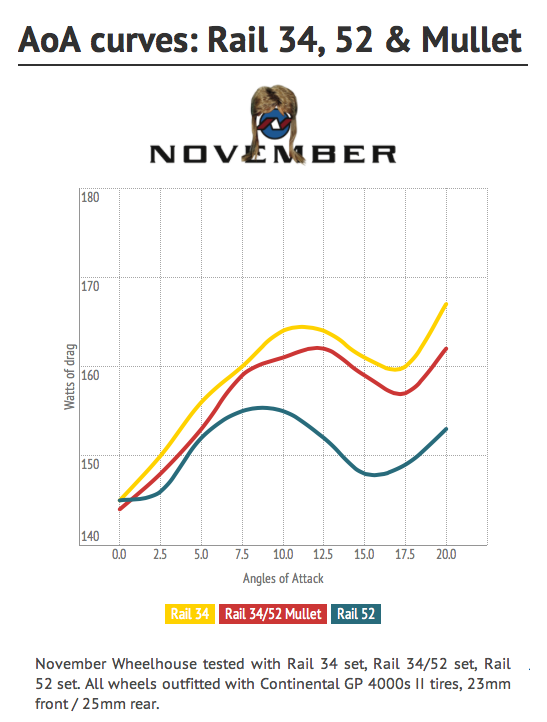 One of the tests we were most curious about was "the mullet." Our lovingly pejorative label for the 34 front/52 rear combo aside, we get asked about this all the time - "is the tradeoff worth it?" Despite having been accused of pulling the answer out of our rear by various internet eyeball aerodynamicists, we've actually put a bunch of study into it. VeloNews has covered it, and Zipp used to publish offset depth tests, so becoming informed was easy with some Google-fu. In the end you don't know until you test, so test we did.
One of the tests we were most curious about was "the mullet." Our lovingly pejorative label for the 34 front/52 rear combo aside, we get asked about this all the time - "is the tradeoff worth it?" Despite having been accused of pulling the answer out of our rear by various internet eyeball aerodynamicists, we've actually put a bunch of study into it. VeloNews has covered it, and Zipp used to publish offset depth tests, so becoming informed was easy with some Google-fu. In the end you don't know until you test, so test we did.
First we have to start off with a disclaimer. I move around too much on the bike to be used as a pedaling dummy. My mom would say "of course not - I didn't raise no dummy," but my active riding style meant that it was impossible to do the "rider on" portion of this test. More on this later, because it takes some special skill to be silent enough on a road bike to be a good dummy, and this has some ramifications.
Anyhow, to answer the mullet question, we ran three tests - 34s front and rear, 52s front and rear, and 34 front/52 rear. What we found was approximately precisely what we'd guessed - that the rear wheel accounts for less of the aerodynamics than the front. There's some "there" there, but the assumption that a wheel's benefit is the same front or rear is debunked. If they were equally important, the 34/52 set should have been a 50% closure of the gap to the 52/52 set from the 34/34 set. As it happened, it only crossed about a third of the gap.

The major motivation for people to do the offset set is to get the crosswind handling benefit of the shallower front with the aerodynamic benefit of the deeper rear. As it turns out, A2 is now able to quantify that as well, which will become part of the story soon. As sticky as it is to editorialize on data, everyone's still going to ask us if it's worth it, so having tested, our answer will be thus. If you want the shallower front in order to save weight, we've never seen a model where the sacrifice in aerodynamics would be worth the benefit in reduced weight. If you want all the aerodynamics you can get but are incontrovertibly certain that a 52mm deep wheel is too much to handle, then there is a bit of benefit to be gotten from the setup. As ever, my wording on the last sentence turns out to be quite meaningful.


7 comments
Did you also test the Flock of Seagulls combo with the 52 in front and the easier to spin up 34 in the back?
In fact, we did not. You can certainly infer, based on the amount of the load obviously carried by the front wheel, that it would be the superior hairstyle. But it's just too expensive to test everything.
Joe Bond,Little known fact in the cycling world is that the power required to spin up a wheel is actually less for deeper wheels, not more. The small additional power required due to the extra mass is more than made up for in improved aerodynamics, even in the rear! Not pictured in these wind tunnel tests is the power required to spin the wheel through the air, which will typically be about 1-3 watts of savings for a deeper wheel, which would be in addition to the small transnational advantage shown here.Also, using a deep front and shallow rear is often worse handling than deep front and deep rear. It can be a sensible option to go deep front shallow rear occasionally though, such as uphill time trials where handling isn't an issue, and you want to meet the minimum weight, and be as aero as possible.
Is the watts of drag verses angle of attack done at a certain speed going forward.Or in the case of the wind tunnel a perceived speed going forward. It would seem that this would vary, based on forward speed also. would be nice to see this curve at 20 MPH, 30 MPH, and 40 MPH.
Jack Mott – Thanks for that Jack Mentink – As labeled on the upper graphic, This is at 30mph, which is a 30mph wind blowing over a stationary, spinning wheel. We will be scaling this speed down when showing other results – to 20 and 25 mph. But tests done inside the tunnel are always done with 30mph wind speed, the scaling is handled by formulas and software.